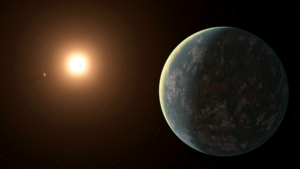 Artist concept of the Gliese 357 (GJ357) system. Credit: Jack Madden | |
| Observation data Epoch J2000 Equinox J2000 | |
|---|---|
| Constellation | Hydra |
| Right ascension | 09 36 01.63722 |
| Declination | −21° 39′ 38.8776″ |
| Apparent magnitude (V) | 10.906 |
| Characteristics | |
| Evolutionary stage | main sequence |
| Spectral type | M2.5V |
| Astrometry | |
| Radial velocity (Rv) | −35.03±0.17 km/s |
| Proper motion (μ) | RA: 138.722±0.023 mas/yr Dec.: −990.342±0.020 mas/yr |
| Parallax (π) | 105.9789 ± 0.0227 mas |
| Distance | 30.776 ± 0.007 ly (9.436 ± 0.002 pc) |
| Absolute magnitude (MV) | +11.13 |
| Details | |
| Mass | 0.362 M☉ |
| Radius | 0.333 R☉ |
| Luminosity | 0.014 L☉ |
| Surface gravity (log g) | 4.96 cgs |
| Temperature | 3,488 K |
| Metallicity | −0.14 dex |
| Rotation | 74.3±1.7 d |
| Rotational velocity (v sin i) | 2.5 km/s |
| Other designations | |
| HIP 47103, 2MASS 09360161-2139371, TOI 562 | |
| Database references | |
| SIMBAD | data |
GJ 357 (Gliese 357) is an M-type main sequence star with an unusually low star spot activity. It is located 31 light-years from the Solar System, in the Hydra constellation.
Planetary system
The star has three confirmed exoplanets in its orbit. One of these, Gliese 357 d, is considered to be a "super-Earth" within the circumstellar habitable zone.
Planets b and c are close to 3:7 mean-motion resonance. Presuming resonance chain extends to the outermost, cold, super-terrestrial Gliese 357 d and the resonances are simple, GJ 357 might have a more suitable planet for life with an approximate 27.5 day period and almost Earth's flux. Additionally, it might host a Mars-sized planet in 2:1 period ratio with GJ 357 c and 2:3 ratio with hypothetical HZ rocky planet.
| Companion (in order from star) |
Mass | Semimajor axis (AU) |
Orbital period (days) |
Eccentricity | Inclination | Radius |
|---|---|---|---|---|---|---|
| b | 1.84±0.31 M🜨 | 0.035±0.002 | 3.93072+0.00008 −0.00006 |
0.047 −0.047 |
89.12+0.37 −0.31° |
1.217+0.084 −0.083 R🜨 |
| c | ≥3.40±0.46 M🜨 | 0.061±0.004 | 9.1247+0.0011 −0.0010 |
0.072±0.053 | — | — |
| d | ≥6.1±1.0 M🜨 | 0.204±0.015 | 55.661±0.055 | 0.033 −0.033 |
— | — |
References
- ^ Vallenari, A.; et al. (Gaia collaboration) (2023). "Gaia Data Release 3. Summary of the content and survey properties". Astronomy and Astrophysics. 674: A1. arXiv:2208.00211. Bibcode:2023A&A...674A...1G. doi:10.1051/0004-6361/202243940. S2CID 244398875. Gaia DR3 record for this source at VizieR.
- Koen, C.; Kilkenny, D.; Van Wyk, F.; Marang, F. (2010). "UBV(RI)C JHK observations of Hipparcos-selected nearby stars". Monthly Notices of the Royal Astronomical Society. 403 (4): 1949. Bibcode:2010MNRAS.403.1949K. doi:10.1111/j.1365-2966.2009.16182.x.
- Gray, R. O.; Corbally, C. J.; Garrison, R. F.; McFadden, M. T.; Bubar, E. J.; McGahee, C. E.; O'Donoghue, A. A.; Knox, E. R. (2006). "Contributions to the Nearby Stars (NStars) Project: Spectroscopy of Stars Earlier than M0 within 40 pc-The Southern Sample". The Astronomical Journal. 132 (1): 161–170. arXiv:astro-ph/0603770. Bibcode:2006AJ....132..161G. doi:10.1086/504637. S2CID 119476992.
- ^ Houdebine, E. R.; Mullan, D. J.; Paletou, F.; Gebran, M.; Bubar, E. J.; McGahee, C. E.; O'Donoghue, A. A.; Knox, E. R. (2016). "Rotation-Activity Correlations in K and M Dwarfs. I. Stellar Parameters and Compilations of v sin I and P/Sin I for a Large Sample of Late-K and M Dwarfs". The Astrophysical Journal. 822 (2): 97. arXiv:1604.07920. Bibcode:2016ApJ...822...97H. doi:10.3847/0004-637X/822/2/97. S2CID 119118088.
- ^ Passegger, V. M.; Reiners, Ansgar; Jeffers, S. V.; Wende-von Berg, S.; Schöfer, P.; Caballero, J. A.; Schweitzer, A.; Amado, P. J.; Béjar, V. J. S.; Cortés-Contreras, M.; Hatzes, A. P.; Kürster, M.; Montes, D.; Pedraz, S.; Quirrenbach, A.; Ribas, I.; Seifert, W. (2018). "The CARMENES search for exoplanets around M dwarfs. Photospheric parameters of target stars from high-resolution spectroscopy". Astronomy and Astrophysics. 615: A6. arXiv:1802.02946. Bibcode:2018A&A...615A...6P. doi:10.1051/0004-6361/201732312. S2CID 55639432.
- Morales, J. C.; Ribas, I.; Jordi, C.; McFadden, M. T.; Bubar, E. J.; McGahee, C. E.; O'Donoghue, A. A.; Knox, E. R. (2008). "The effect of activity on stellar temperatures and radii". Astronomy and Astrophysics. 478 (2): 507. arXiv:0711.3523. Bibcode:2008A&A...478..507M. doi:10.1051/0004-6361:20078324. S2CID 16238033.
- Suárez Mascareño, A.; Rebolo, R.; González Hernández, J. I.; Esposito, M. (2015), "Rotation periods of late-type dwarf stars from time series high-resolution spectroscopy of chromospheric indicators", Monthly Notices of the Royal Astronomical Society, 452 (3): 2745–2756, arXiv:1506.08039, Bibcode:2015MNRAS.452.2745S, doi:10.1093/mnras/stv1441
- Modirrousta-Galian, D.; Stelzer, B.; Magaudda, E.; Maldonado, J.; Güdel, M.; Sanz-Forcada, J.; Edwards, B.; Micela, G. (2020), "A Super-Earth Orbiting an Extremely Inactive Host Star", Astronomy & Astrophysics, A113: 641, arXiv:2007.10262, doi:10.1051/0004-6361/202038280, S2CID 220647396
- ^ Reddy, Francis; Center, NASA’s Goddard Space Flight (2019-07-31). "TESS Discovers Habitable Zone Planet in GJ 357 System". SciTechDaily. Archived from the original on 2019-08-01. Retrieved 2019-08-01.
- "The Extrasolar Planet Encyclopaedia — Gj 357 b". Extrasolar Planets Encyclopaedia. 1995. Archived from the original on 2023-11-07. Retrieved 2019-08-01.
- Falconer, Rebecca, Newly uncovered super-Earth 31 light-years away may be habitable Archived 2019-12-18 at the Wayback Machine, Axios, August 1, 2019
- "Potentially habitable 'super-Earth' discovered just 31 light-years away". NBC News. 31 July 2019. Archived from the original on 2019-07-31. Retrieved 2019-08-01.
- Garner, Rob (2019-07-30). "NASA's TESS Helps Find Intriguing New World". NASA. Archived from the original on 2019-08-01. Retrieved 2019-08-01.
- Luque, R.; Pallé, E.; et al. (August 2019). "Planetary system around the nearby M dwarf GJ 357 including a transiting, hot, Earth-sized planet optimal for atmospheric characterization". Astronomy & Astrophysics. 628: A39. arXiv:1904.12818. Bibcode:2019A&A...628A..39L. doi:10.1051/0004-6361/201935801. S2CID 139102184.
| Constellation of Hydra | |||||||||||||||
|---|---|---|---|---|---|---|---|---|---|---|---|---|---|---|---|
| Stars |
| ||||||||||||||
| Star clusters |
| ||||||||||||||
| Nebulae |
| ||||||||||||||
| Galaxies |
| ||||||||||||||
| Galaxy clusters |
| ||||||||||||||
| Astronomical events | |||||||||||||||
This article about a red dwarf is a stub. You can help Misplaced Pages by expanding it. |